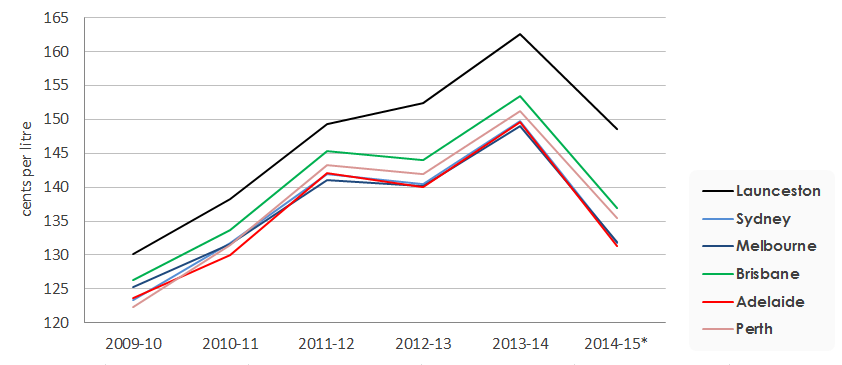The Australian Competition and Consumer Commission has announced that Launceston will be the second regional location to be studied as part of the petrol monitoring arrangements launched by the Minister for Small Business, the Hon Bruce Billson MP, in December 2014.
The in-depth regional market studies aim to explain each component of the prices paid at the bowser to understand why prices are higher in some regional locations.
“Launceston petrol prices are among the highest in Australia. The average annual retail petrol price in Launceston was 162.6 cents per litre (cpl) in 2013-14, some 12cpl higher than the five largest capital cities. Furthermore, this differential has doubled since 2009-10,” ACCC Chairman Rod Sims said.
“These regional fuel market studies are about ensuring transparency about the key drivers of regional petrol prices. They have the potential to empower regional communities and various levels of government with information and recommendations that assist their decision-making. We may also uncover a breach of the Competition and Consumer Act that was not otherwise apparent.”
“We also believe the Launceston study will shed light on a range of petrol pricing issues in Tasmania generally,” Mr Sims said.
The ACCC commenced its first regional market study in Darwin in March 2015 and will release the report of that study later this year. It also expects to report on the Launceston market study by the end of this year. The ACCC will announce the third regional location to be selected for a market study in the coming months.
“Our previous price monitoring work had a strong focus on explaining the common price drivers across Australia. Under the new petrol price direction we are now examining the price drivers that explain what is happening at a local level,” Mr Sims said.
Companies throughout the supply chain will be required to provide information to the ACCC under the compulsory information gathering powers it has under section 95ZK of the Competition and Consumer Act 2010.
“We acknowledge that using compulsory information gathering notices will have an effect upon those receiving them. However, we need to balance this against the need for information to understand pricing in the supply chain,” Mr Sims said.
The ACCC is also interested in obtaining information from consumers, industry participants, stakeholders and any other interested parties regarding the petroleum industry in Launceston. Relevant information can be provided to the ACCC via its website at our consultation hub by 31 July 2015.
Background
On 9 December 2014, Minister Billson directed the ACCC to monitor the prices, costs, and profits relating to the supply of unleaded petroleum products and report at least quarterly for a period of three years.
Under these arrangements the ACCC will produce two types of reports in 2015:
- quarterly macro reports looking at petrol price movements and what drives them overall; and
- market studies looking at micro issues in considerable depth, including analysing the price drivers of petrol in three regional markets.
The first of the macro reports was released in March 2015. See Quarterly report on the Australian petroleum industry - February 2015
Darwin was announced as the location of the first regional market study on 10 March 2015. See ACCC announces first regional petrol market study in Darwin
The ACCC monitors fuel prices in all capital cities and around 180 regional locations across Australia.
Retail petrol prices in Launceston and the five largest cities
The chart below shows annual average retail regular unleaded petrol prices in Launceston compared with those in the five largest cities for the period 2009-10 to 2014-15 year to date (i.e. to 31 March 2015). The difference between the average annual price in Launceston and the average of the five largest cities doubled from 5.9 cpl in 2009-10 to 12.0 cpl in 2013-14.

Source: ACCC calculations based on Informed Sources and FUELtrac data.
Note: *2014-15 financial year average to 31 March 2015.
Prices in Sydney from 1 July 2014 are for E10 instead of regular unleaded petrol



